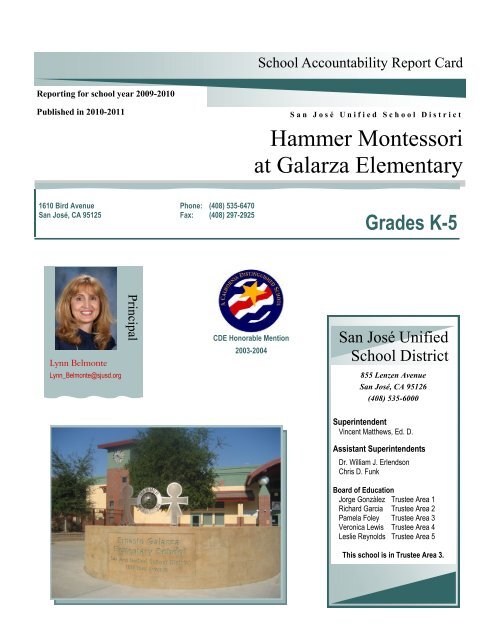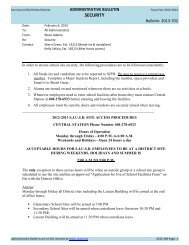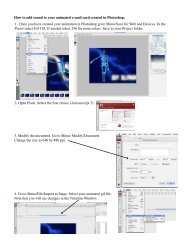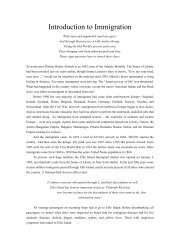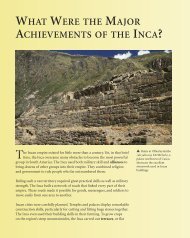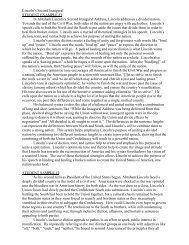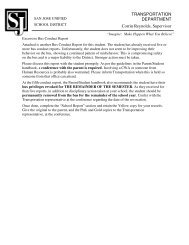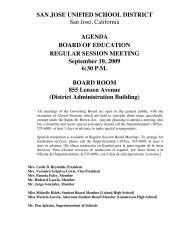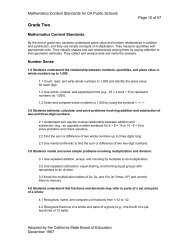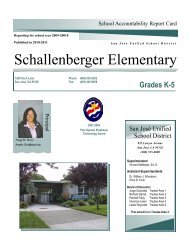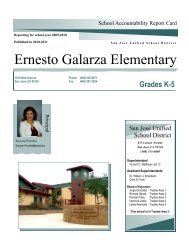Hammer Montessori at Galarza Elementary
Hammer Montessori at Galarza Elementary
Hammer Montessori at Galarza Elementary
Create successful ePaper yourself
Turn your PDF publications into a flip-book with our unique Google optimized e-Paper software.
Reporting for school year 2009-2010<br />
Lynn Belmonte<br />
Lynn_Belmonte@sjusd.org<br />
Principal<br />
CDE Honorable Mention<br />
2003-2004<br />
School Accountability Report Card<br />
Published in 2010-2011 S a n J o s é U n i f i e d S c h o o l D i s t r i c t<br />
<strong>Hammer</strong> <strong>Montessori</strong><br />
<strong>at</strong> <strong>Galarza</strong> <strong>Elementary</strong><br />
1610 Bird Avenue<br />
San José, CA 95125<br />
Phone: (408) 535-6470<br />
Fax: (408) 297-2925<br />
Grades K-5<br />
San José Unified<br />
School District<br />
855 Lenzen Avenue<br />
San José, CA 95126<br />
(408) 535-6000<br />
Superintendent<br />
Vincent M<strong>at</strong>thews, Ed. D.<br />
Assistant Superintendents<br />
Dr. William J. Erlendson<br />
Chris D. Funk<br />
Board of Educ<strong>at</strong>ion<br />
Jorge Gonzàlez Trustee Area 1<br />
Richard Garcia Trustee Area 2<br />
Pamela Foley Trustee Area 3<br />
Veronica Lewis Trustee Area 4<br />
Leslie Reynolds Trustee Area 5<br />
This school is in Trustee Area 3.
<strong>Hammer</strong> <strong>Montessori</strong> <strong>at</strong> <strong>Galarza</strong><br />
Principal’s Comments<br />
This year we continue our goal of bringing together the two schools, which occupy the Ernesto <strong>Galarza</strong> site, into one community. <strong>Hammer</strong><br />
<strong>Montessori</strong> @ <strong>Galarza</strong> has trained staff members who are committed to putting children first. They work together to provide an instructional<br />
program in ELA, M<strong>at</strong>h, Science, and Social Studies while embedding the <strong>Montessori</strong> philosophy. They use the many resources <strong>at</strong> our school<br />
to support the students and parents. The use of technology is integr<strong>at</strong>ed through out the curriculum. The <strong>Hammer</strong> <strong>Montessori</strong> staff and<br />
community work together to ensure student success and academic achievement as well as promoting life long learning.<br />
Vision<br />
Mission<br />
“TWO SCHOOLS, ONE COMMUNITY” “PUTTING CHILDREN FIRST”<br />
“VISION, PASSION, PURPOSE”<br />
The mission of <strong>Hammer</strong> <strong>Montessori</strong> is to facilit<strong>at</strong>e an educ<strong>at</strong>ional environment, which promotes independent and self-directed learning by the way<br />
of the <strong>Montessori</strong> philosophy. To th<strong>at</strong> end, we nurture: a child-centered learning environment, a responsive prepared environment, a focus on<br />
independent progress and development, hands on and active learning, multi-ability grouping, and cooper<strong>at</strong>ion and collabor<strong>at</strong>ion where our<br />
students value global understanding, service to others, and universal values. We value parent particip<strong>at</strong>ion and encourage all families to become<br />
involved. Family nights, parent educ<strong>at</strong>ion classes, interactive homework assignments, and PTA encourage families to support the instructional<br />
environment and promote a passion for learning.<br />
School Goals:<br />
The use of current instructional curriculum and best practices str<strong>at</strong>egies<br />
Embed the <strong>Montessori</strong> Philosophy into the curriculum<br />
Provide a positive schools clim<strong>at</strong>e and culture<br />
The use of d<strong>at</strong>a to drive all decisions<br />
Cre<strong>at</strong>e an effective teaching community<br />
Expand our Parent and teacher partnership<br />
The continual pursuit of professional development and growth<br />
Principal’s Experience<br />
Susana Ornelas- Paredes came to <strong>Hammer</strong> as the principal in the fall of 2007. Prior to th<strong>at</strong>, she worked for two years as the Assistant Principal <strong>at</strong><br />
Allen <strong>at</strong> Steinbeck. While there, she successfully merged the Randol and Allen communities. She has also worked as an ELP Coordin<strong>at</strong>or <strong>at</strong> the<br />
site and district levels. Mrs. Ornelas-Paredes has more than 10 years of direct classroom teaching experience <strong>at</strong> the elementary level in Bilingual<br />
Educ<strong>at</strong>ion and ELD. During her time <strong>at</strong> <strong>Hammer</strong> <strong>Montessori</strong> she has successfully merged the two schools th<strong>at</strong> share the campus into one<br />
community. Mrs. Ornelas- Paredes has been a strong advoc<strong>at</strong>e for the <strong>Montessori</strong> program, and worked closely with the district to identify a<br />
design<strong>at</strong>ed administr<strong>at</strong>or to oversee the <strong>Montessori</strong> instructional program for the 2010-2011 school year. Lynn Belmonte became the associ<strong>at</strong>e<br />
principal of <strong>Hammer</strong> in the summer of 2010. She has been with <strong>Hammer</strong> <strong>Montessori</strong> since it opened in 1997. Mrs. Belmonte received a master‘s<br />
degree in <strong>Montessori</strong> Educ<strong>at</strong>ion in 1999 and was the resource teacher for the past 8 years. She has been successful in growing the <strong>Montessori</strong><br />
program <strong>at</strong> the <strong>Galarza</strong> site.<br />
Major Achievements<br />
API of 845 (15 point growth)<br />
Achieved AMAO1 Targets for ELL<br />
Achieved AMAO2 Targets for ELL<br />
Implemented Positive Behavior Intervention and Supports Program (PBIS)<br />
► 2
<strong>Hammer</strong> <strong>Montessori</strong> <strong>at</strong> <strong>Galarza</strong><br />
Demographics<br />
The chart and table below show the number of students enrolled in each grade level and the percent of students enrolled who are identified as<br />
being in a particular group during the 2008-2009 school year.<br />
Number of students <strong>at</strong> the Grade<br />
Level<br />
73<br />
Class Size<br />
52<br />
Total students: 275<br />
36<br />
Average Class Size and Class Size Distribution<br />
49<br />
39<br />
2007-2008 2008-2009 2009-2010<br />
Grade<br />
Avg.<br />
Class<br />
Size<br />
Number of Classrooms<br />
1-20 21-32 33+<br />
Avg.<br />
Class<br />
Size<br />
Number of Classrooms<br />
1-20 21-32 33+<br />
Avg.<br />
Class<br />
Size<br />
Number of Classrooms<br />
1-20 21-32 33+<br />
K 17.5 2 19.3 3 28.5 2<br />
1 17.5 2<br />
2 17.0 2 17.0 1<br />
3 30.0 1 22.0 1 26.0 1<br />
4 28.0 1 25.0 1<br />
5<br />
6<br />
25.0 1<br />
K-3 17.7 3 19.8 4 27.5<br />
3-4 26.0 1 26.0 4<br />
4-8<br />
Other<br />
27.0 1 26.0 2 1<br />
This table displays by grade level the average class size and the number of classrooms<br />
th<strong>at</strong> fall into each size c<strong>at</strong>egory (a range of total students per classroom).<br />
26<br />
K 1st 2nd 3rd 4th 5th<br />
Student Enrollment by group<br />
African American 8.36 %<br />
American Indian or Alaska N<strong>at</strong>ive 0 %<br />
Asian 17.45 %<br />
Filipino 2.18 %<br />
Hispanic or L<strong>at</strong>ino 37.09 %<br />
Pacific Islander 0.73 %<br />
White (Not Hispanic) 29.82 %<br />
Multiple or No Response %<br />
Socioeconomically disadvantaged 38.00 %<br />
English Learners 12.00 %<br />
Students with disabilities 14.00 %<br />
► 3
<strong>Hammer</strong> <strong>Montessori</strong> <strong>at</strong> <strong>Galarza</strong><br />
Parent Ambassadors cre<strong>at</strong>ed to connect incoming parents<br />
New school garden established<br />
Increased enrollment from 250 to 320<br />
Parental Involvement<br />
Parents are involved in the governance of <strong>Hammer</strong> <strong>Montessori</strong> by particip<strong>at</strong>ing in monthly School Site Council (SSC) and School English<br />
Language Advisory Council (SELAC) meetings. Parent volunteers work in the classroom, coordin<strong>at</strong>e classroom projects, chaperone field trips<br />
and assist with special activities. Our PTA holds monthly meetings regarding school programs and provides monetary support services for all<br />
students. PTA sponsors our annual Walk-A Thon. At the monthly ―Principal‘s Coffee,‖ parents are informed and upd<strong>at</strong>ed on current school<br />
activities. Parents are also encouraged to particip<strong>at</strong>e in on-going workshops. <strong>Montessori</strong> demonstr<strong>at</strong>ions are also offered. The <strong>Hammer</strong><br />
<strong>Montessori</strong> Found<strong>at</strong>ion (HMF) helps provide funding for student enrichment and <strong>Montessori</strong> training for teachers. If you are interested in<br />
becoming more involved <strong>at</strong> your child‘s school, you may contact the school regarding your interests or concerns. For further inform<strong>at</strong>ion, please<br />
contact our parent liaison, Lou Esquivel <strong>at</strong> 408 535-6671.<br />
Clim<strong>at</strong>e for Learning<br />
Safety<br />
D<strong>at</strong>e safety plan upd<strong>at</strong>ed: October 2010<br />
D<strong>at</strong>e safety plan last reviewed with staff: November 2010<br />
By the end of each September, Safety Plans are reviewed annually. The key element in the plan is student safety as well as their respect for one<br />
another. Staff members reviewed liter<strong>at</strong>ure and visited other campuses in search of a ways to uniformly promote a behavior plan th<strong>at</strong> would<br />
encourage all students to show respect and, as a result, feel safe.<br />
Providing a safe, clean, and secure learning environment is important to the <strong>Hammer</strong> faculty and community. A school-wide behavior<br />
management plan is in place with school and classroom behavioral expect<strong>at</strong>ions th<strong>at</strong> are reinforced throughout the year. Yard Duty personnel and<br />
bus supervisors are hired to supervise students from the bus area before school. After school, students are also supervised in the valet area,<br />
which is loc<strong>at</strong>ed <strong>at</strong> the front of the school. In addition, students are supervised in the Bus Zone as well. A well supplied, secured storage area<br />
houses emergency supplies. Regular preparedness and safety drills are conducted in accordance with district guidelines.<br />
Homework<br />
Homework is assigned, based on the expect<strong>at</strong>ions <strong>at</strong> specific grade levels and in specific classrooms. It is assigned to provide additional practice<br />
of new and previously learned concepts, and may include both long and short-term projects. Homework is also used as a way to involve parents<br />
in the schooling and to keep them abreast of classroom academics.<br />
Discipline<br />
<strong>Hammer</strong> <strong>Montessori</strong> has a school-wide behavior<br />
management plan called Positive Behavioral<br />
Interventions and Supports (PBIS) to promote a<br />
positive learning environment and respect of the<br />
individual. Individual classroom standards reinforce<br />
positive behavior as well as specific consequences for<br />
inappropri<strong>at</strong>e behavior. We believe th<strong>at</strong> students who<br />
have positive self-esteem and have opportunities to be<br />
connected to their school environment, through<br />
Suspensions and Expulsions—3 year comparison<br />
School District<br />
2007-08 2008-09 2009-10 2007-08 2008-09 2009-10<br />
R<strong>at</strong>e of Suspensions 10.7% 7.9% 2.91% 13.6% 11.8% 5.17%<br />
R<strong>at</strong>e of Expulsions 0.0% 0.0% 0.0% 0.2% 0.2% 0.19%<br />
service, perform better academically and socially. We also understand there is always a reason for a student‘s misbehavior. Through discussion<br />
with the student, the teacher, the parent, and the counselor, we work to get <strong>at</strong> the root of the problem to elimin<strong>at</strong>e the neg<strong>at</strong>ive behavior.<br />
► 4<br />
This table displays the r<strong>at</strong>e of suspensions and expulsions (total number of incidents divided<br />
by the total enrollment) <strong>at</strong> the school and district levels for the most recent three-year period.
<strong>Hammer</strong> <strong>Montessori</strong> <strong>at</strong> <strong>Galarza</strong><br />
Each student has a specific role and responsibility in maintaining the school environment. School wide, students particip<strong>at</strong>e in a variety of<br />
programs, including Expect/Respect Workshop, Student Leadership, Cross-Age tutoring, and recess coaches trained by Play Works.<br />
Facilities<br />
The 2003-2004 school year found <strong>Hammer</strong> <strong>Montessori</strong> School in a different loc<strong>at</strong>ion. We now share the beauty of a ten - year old site with <strong>Galarza</strong><br />
<strong>Elementary</strong> School in SJUSD. The two-story, ‗closed‘ environment provides a safe learning <strong>at</strong>mosphere for all students and staff. During the<br />
summer of 2010, new exits on the second floor were cre<strong>at</strong>ed. Fixtures, appliances, and facilities are all new and in working condition. One<br />
daytime custodian is responsible for the cleanliness of all student b<strong>at</strong>hrooms, the cafeteria, and the emptying of trash throughout the school. A<br />
This table displays the results of the most recently completed school site inspection to determine the school facility’s good repair<br />
st<strong>at</strong>us. Each area/classroom of the school is inspected. A “deficiency” is counted for each occurrence of a condition. Descriptions of<br />
similar deficiencies are combined r<strong>at</strong>her than to list by classroom.<br />
System Inspected Exemplary Good Fair Poor<br />
Systems: Gas Leaks, Mechanical/HVAC, Sewer <br />
Interior: Interior Surfaces <br />
Cleanliness: Overall Cleanliness, Pest/ Vermin<br />
Infest<strong>at</strong>ion<br />
Electrical: Electrical <br />
Restrooms/Fountains: Restrooms, Sinks/ Fountains<br />
Safety: Fire Safety, Hazardous M<strong>at</strong>erials <br />
Structural: Structural Damage, Roofs <br />
External: Playground/School Grounds, Windows/<br />
Doors/G<strong>at</strong>es/Fences<br />
Overall Summary of School Facility Good Repair St<strong>at</strong>us as of August 25, 2010<br />
Facility Condition Exemplary Good Fair Poor<br />
<br />
<br />
<br />
Overall R<strong>at</strong>ing Inspected by Santa<br />
Clara County Office<br />
► 5<br />
Repair needed and action taken or<br />
planned<br />
There were 2 deficiencies in this<br />
area. There were for lights out in Rm<br />
-115 and Hallway.
<strong>Hammer</strong> <strong>Montessori</strong> <strong>at</strong> <strong>Galarza</strong><br />
Teacher and Staff Inform<strong>at</strong>ion<br />
Teacher Credentials<br />
Teachers<br />
School District<br />
2007-08 2008-09 2009-10 2009-10<br />
With Full Credential 14 14 11<br />
1360<br />
Without Full Credential 0 0 0<br />
59<br />
Teaching Outside Subject Area of Competence 0 0 0<br />
0<br />
This table displays the number of teachers assigned to the school with a full credential,<br />
without a full credential, and those teaching outside of their subject area of competence.<br />
Teacher Misassignments and Vacant Teacher Positions<br />
Indic<strong>at</strong>or 2007-08 2008-09 2009-10<br />
Misassignments of Teachers of English Learners 0 0 0<br />
Total Teacher Misassignments 0 0 0<br />
Vacant Teacher Positions 0 0 0<br />
Teacher misassignments (teachers assigned without proper legal authoriz<strong>at</strong>ion)<br />
Note: Total Teacher Misassignments includes the number of Misassignments of<br />
Teachers of English Learners.<br />
Vacant teacher positions (not filled by a single design<strong>at</strong>ed teacher assigned to teach the entire<br />
course <strong>at</strong> the beginning of the school year or semester).<br />
Core Academic Classes Taught by NCLB Compliant<br />
Teachers<br />
This School<br />
All Schools in District<br />
High Poverty Schools<br />
Low Poverty Schools<br />
98.3%<br />
99.1%<br />
99.2%<br />
100.0%<br />
Detailed inform<strong>at</strong>ion<br />
about teacher<br />
qualific<strong>at</strong>ions can be<br />
found <strong>at</strong> the CDE Web<br />
site <strong>at</strong><br />
http://dq.cde.ca.gov/<br />
d<strong>at</strong>aquest/.<br />
► 6<br />
The No Child Left Behind Act (NCLB) requires th<strong>at</strong> all teachers<br />
teaching in core academic subjects are to be "highly qualified".<br />
In general, NCLB requires th<strong>at</strong> each teacher must have:<br />
A bachelor's degree<br />
A st<strong>at</strong>e credential or an Intern Certific<strong>at</strong>e/Credential for no more than<br />
three years<br />
Demonstr<strong>at</strong>ed subject m<strong>at</strong>ter competence for each core subject to be<br />
taught by the teacher.<br />
This is chart displays the percent of classes in core academic<br />
classes taught by No Child Left Behind (NCLB) compliant<br />
teachers in the following areas:<br />
Teachers <strong>at</strong> this school<br />
Teachers in the District<br />
High poverty schools (student particip<strong>at</strong>ion of 75% or more in<br />
free and reduced meals program)<br />
Low poverty schools (student particip<strong>at</strong>ion of 25% or less in the<br />
free and reduced meals program)<br />
More inform<strong>at</strong>ion on teacher qualific<strong>at</strong>ions required under<br />
NCLB can be found <strong>at</strong> the California Department of Educ<strong>at</strong>ion's<br />
Web site <strong>at</strong> http://www.cde.ca.gov/nclb/sr/tq/.
<strong>Hammer</strong> <strong>Montessori</strong> <strong>at</strong> <strong>Galarza</strong><br />
district coordin<strong>at</strong>ed ‗night-crew‘ is assigned for two hours daily to vacuum stairways, maintain the office, health office, staff room and adult<br />
b<strong>at</strong>hrooms. A weekly grounds crew is present to weed, rake, w<strong>at</strong>er and complete general yard work.<br />
Teacher and Staff Inform<strong>at</strong>ion<br />
Evalu<strong>at</strong>ing/Improving Teachers<br />
In accordance with the SJTA teacher‘s contract, temporary and prob<strong>at</strong>ionary teachers are assessed twice a year, while permanent teachers are<br />
assessed every other year. Evalu<strong>at</strong>ions are based on the District protocol th<strong>at</strong> is aligned to the California Standards for the Teaching Profession,<br />
with different expectancies analyzed on a four-level rubric. Each teacher who is evalu<strong>at</strong>ed will have a pre/post conference. The evalu<strong>at</strong>ions are<br />
sent to human resources.<br />
To determine the classroom goals, our teachers set grade level goals as well as individual goals based on student work and St<strong>at</strong>e test d<strong>at</strong>a. This<br />
is done on the one to one with site administr<strong>at</strong>ors in mid October. The teachers will meet with the site administr<strong>at</strong>ors three more times through out<br />
the school year (January, April and l<strong>at</strong>e may) to review their goals and make changes as necessary. We take our prepar<strong>at</strong>ion as professionals<br />
very seriously by setting aside time after school to <strong>at</strong>tend trainings in m<strong>at</strong>h and writing. Our District gives a mentor all new teachers. In the<br />
<strong>Montessori</strong> setting, we also evalu<strong>at</strong>e to ensure the <strong>Montessori</strong> philosophy is being upheld to its highest standard.<br />
Professional Development<br />
The district allots six days of staff development throughout the year. In the beginning of the year, meetings are reserved for analysis of test scores<br />
and student achievement from the previous year. This is the time to realign our goals with current student needs. One Staff development day in<br />
the fall is reserved for Parent Teacher conferences and one in the spring focuses on multicultural aspects of educ<strong>at</strong>ion. Other days are used for<br />
additional focus on improving the academic needs of our students. Professional speakers are invited and grade level teaming/planning is always<br />
integr<strong>at</strong>ed. Our staff regularly initi<strong>at</strong>es on-going <strong>Montessori</strong> professional development on a monthly basis. Staff collabor<strong>at</strong>es on an on-going basis<br />
as well as visiting other schools and/or <strong>at</strong>tends district trainings. These trainings have included Observ<strong>at</strong>ion Surveys, Running Records, Step Up<br />
to Writing, Write Tools, Board M<strong>at</strong>h, Direct Instruction, SPARK, Mind Maps, Multiple Intelligences, CLAD, and SDAIE. In addition, the <strong>Hammer</strong><br />
staff has been extensively trained in First Aid and CPR. All classroom teachers have completed extensive <strong>Montessori</strong> training and credentialing.<br />
► 7
<strong>Hammer</strong> <strong>Montessori</strong> <strong>at</strong> <strong>Galarza</strong><br />
Substitute Teachers<br />
<strong>Hammer</strong> <strong>Montessori</strong> is able to send teachers to conferences and meetings because of the pool of excellent substitutes. We are gr<strong>at</strong>eful to<br />
many San Jose Unified retired teachers and currently credentialed parents who provide consistency and warmth in the absence of regular<br />
classroom teachers.<br />
Support Staff:<br />
<strong>Hammer</strong> <strong>Montessori</strong> has the following certific<strong>at</strong>ed and classified support staff:<br />
One full time Resource Teacher<br />
One part-time RSP teacher<br />
One part-time Speech Therapist<br />
Five part-time Instructional Associ<strong>at</strong>es<br />
One .10 Occup<strong>at</strong>ional Therapist<br />
Two part-time counselors<br />
Curriculum<br />
Reading and Writing<br />
Our <strong>Montessori</strong> teachers are trained in early literacy str<strong>at</strong>egies with an emphasis on intervention techniques, such as running records, shared/<br />
guided reading, anecdotal records,<br />
observ<strong>at</strong>ion survey, rubrics, and altern<strong>at</strong>e<br />
rankings. The Houghton-Mifflin District<br />
adoption is used as our basal text. We also<br />
use many supplementary m<strong>at</strong>erials th<strong>at</strong><br />
include core liter<strong>at</strong>ure books <strong>at</strong> each grade<br />
level, grammar resources, leveled books,<br />
Acceler<strong>at</strong>ed Reader and other sequenced<br />
<strong>Montessori</strong> m<strong>at</strong>erials. Students review daily<br />
using Str<strong>at</strong>egic Schooling str<strong>at</strong>egies based on<br />
problem solving and st<strong>at</strong>e standards.<br />
Teachers engage students in the str<strong>at</strong>egies of<br />
the Write Tools program, which includes prewriting,<br />
drafting, and revising, editing, and post<br />
-writing activities. We also provide the district<br />
Language! intervention program five days a<br />
week.<br />
M<strong>at</strong>h<br />
<strong>Hammer</strong> <strong>Montessori</strong> m<strong>at</strong>h curriculum follows<br />
the st<strong>at</strong>e framework and is defined by six<br />
strands: probability and st<strong>at</strong>istics, numbers<br />
and oper<strong>at</strong>ions, geometry and measurement,<br />
QUALITY, CURRENCY, AND AVAILABILITY OF TEXTBOOKS AND<br />
INSTRUCTIONAL MATERIALS<br />
Reading/<br />
Language Arts<br />
Percent of Pupils Who<br />
Lack Their Own Assigned<br />
Textbooks<br />
and/or Instructional<br />
M<strong>at</strong>erials<br />
Most Recent SBE or Local<br />
Governing Agency Approved<br />
Textbooks and Instructional<br />
M<strong>at</strong>erials<br />
0% No<br />
M<strong>at</strong>hem<strong>at</strong>ics 0% Yes<br />
Foreign Language 0% Yes<br />
Science 0% Yes<br />
History-Social<br />
Science<br />
Health 0%<br />
Science Labor<strong>at</strong>ory<br />
Equipment<br />
(grade 9-12)<br />
0% Yes<br />
K-5 Yes<br />
6-8 No<br />
0% Yes<br />
A list of textbooks and adoption d<strong>at</strong>es is available <strong>at</strong>:<br />
http://www.sjusd.org/schools/document<strong>at</strong>ion/downloads/Textbook_listing.pdf<br />
► 8
<strong>Hammer</strong> <strong>Montessori</strong> <strong>at</strong> <strong>Galarza</strong><br />
function and algebra, m<strong>at</strong>hem<strong>at</strong>ical reasoning, and m<strong>at</strong>hem<strong>at</strong>ical communic<strong>at</strong>ion. Hands-on <strong>Montessori</strong> m<strong>at</strong>erials are integr<strong>at</strong>ed extensively into<br />
the District adopted core curriculum to provide concrete experiences and to facilit<strong>at</strong>e acquisition of basic skills. Students review daily using<br />
Str<strong>at</strong>egic Schooling str<strong>at</strong>egies based on problem solving and st<strong>at</strong>e standards. They test themselves regularly for speed and accuracy using M<strong>at</strong>h<br />
Facts in a Flash (a web-based program.) Grades 3-5 use the Acceler<strong>at</strong>ed M<strong>at</strong>h Program to reinforce concepts taught in their classrooms. M<strong>at</strong>h is<br />
integr<strong>at</strong>ed throughout the curriculum <strong>at</strong> all grade levels.<br />
Science<br />
<strong>Montessori</strong> Science m<strong>at</strong>erials are integr<strong>at</strong>ed into the St<strong>at</strong>e framework and benchmarked District standards. Beginning in kindergarten and<br />
continuing through fifth grade, students learn scientific processes and rel<strong>at</strong>e these to the world around them. A complete array of FOSS Science<br />
kits, developed by the Lawrence Hall of Science provides additional depth and understanding. All fifth graders <strong>at</strong>tend Camp Campbell for a week<br />
of Outdoor Science School. An annual Science Fair, originally begun as a fifth grade project requirement, is now a school wide event. Students in<br />
grades 1 st-5 th also have the opportunity to <strong>at</strong>tend a six-week science workshop. The workshops are geared to each grade levels needs and<br />
interests.<br />
Social Studies<br />
The Social Studies program integr<strong>at</strong>es <strong>Montessori</strong> cultural m<strong>at</strong>erials and philosophy into the California St<strong>at</strong>e Framework. The blended curriculum<br />
integr<strong>at</strong>es liter<strong>at</strong>ure, m<strong>at</strong>h, science, art, and music. We focus on the rel<strong>at</strong>ionship of the child to the bigger concept of time and place in history.<br />
Children research historical characters and prepare present<strong>at</strong>ions and displays for events such as Colonial Days, and Gold Rush Days.<br />
Cooper<strong>at</strong>ive learning and multi-age grouping encourages interaction and collabor<strong>at</strong>ion.<br />
Textbooks<br />
New textbooks are selected from St<strong>at</strong>e approved lists th<strong>at</strong> have been piloted by all grade levels throughout the District. All students have access<br />
to textbooks and supplementary text m<strong>at</strong>erials for class and/or home use in order to complete assigned projects. Additional m<strong>at</strong>erials such as<br />
leveled books and Acceler<strong>at</strong>ed Reading titles and <strong>Montessori</strong> manipul<strong>at</strong>ives help supplement the core curriculum. The Scott Foresman-Addison<br />
Wesley enVision M<strong>at</strong>h Series was adopted in 2009/2010 The Houghton Mifflin reading Series was adopted in 2003/2004. All students have<br />
access to the core curriculum, including texts and other supplemental m<strong>at</strong>erials.<br />
Specialized Programs<br />
GATE<br />
Students are identified based on academic or social performance as well as outside mitig<strong>at</strong>ing factors. Initially, students are taken through the<br />
Student Study Team process to help develop a plan whereby the student‘s needs are addressed. Follow up meetings are held monthly to review<br />
the plan and adjust, as needed. Interventions may include sessions with a counselor, buddy teachers, peer tutoring, Voyager interventions, or<br />
other outside services. Monitoring is done along the timeline of the Student Study Team process.<br />
Special Ed<br />
Through the Student Study Team process and by way of academic testing, students may be eligible for special educ<strong>at</strong>ion services for speech,<br />
reading, language arts, and/or m<strong>at</strong>h. All special educ<strong>at</strong>ion services provided <strong>at</strong> <strong>Hammer</strong> are ‗pull- out‘ programs: the majority of time is spent in<br />
a regular classroom setting with same-ability pull -out groups working with the Resource Teacher for blocks of one – two hours daily. All<br />
progress and goals are monitored in accordance with the individual IEPs.<br />
At-risk students<br />
Students are identified based on academic or social performance as well as outside mitig<strong>at</strong>ing factors. Initially, students are taken through the<br />
Student Study Team process to help develop a plan whereby the student‘s needs are addressed. Follow up meetings are held monthly to review<br />
the plan and adjust, as needed. Interventions may include sessions with a counselor, buddy teachers, peer tutoring, Voyager interventions, or<br />
other outside services. Monitoring is done along the timeline of the Student Study Team process.<br />
English language learners<br />
English learners are provided full access to the balanced core curriculum in English. Sheltered language techniques are imbedded in classroom<br />
instruction. Specific time is scheduled daily for instruction of content and language skills.<br />
► 9
<strong>Hammer</strong> <strong>Montessori</strong> <strong>at</strong> <strong>Galarza</strong><br />
Students with disabilities<br />
<strong>Hammer</strong> School works with the district office to align services for those with disabilities according to the needs outlined in their individual IEP‘s.<br />
Currently, we use RSP, Speech and Occup<strong>at</strong>ional Therapy services.<br />
After-school programs<br />
After-school programs are supported through a grant from the City of San Jose. Our program provides extended day enrichment services to<br />
groups of students needing additional assistance in Reading, Writing, and/or M<strong>at</strong>h. Groups are kept small (6-10 students) and are taught by<br />
credential classroom teachers. Additionally after school homework assistance, childcare and enrichment activities are provided through a<br />
partnership with the YMCA.<br />
Peer tutoring<br />
Peer tutoring is implemented in a variety of ways and for a variety of reasons. Upper and lower grade teachers will partner their classes for Peer<br />
Tutoring in Reading. Kinder teachers invite fifth grade students into the classroom to read to their students. Students needing a boost in selfesteem<br />
and sense of belonging, will return to their previous year‘s teachers and assist in the classroom with student work. <strong>Montessori</strong> educ<strong>at</strong>ion<br />
believes in combin<strong>at</strong>ion classrooms where peer tutoring is a n<strong>at</strong>ural process between grade levels.<br />
► 10
<strong>Hammer</strong> <strong>Montessori</strong> <strong>at</strong> <strong>Galarza</strong><br />
School Finances (Fiscal Year 2008-2009)<br />
Expenditures Per Pupil and School Site Teacher Salaries<br />
Level<br />
Types of Services Funded<br />
Total Expenditures<br />
per Pupil<br />
Restricted<br />
(supplemental)<br />
expenditures per<br />
Unrestricted<br />
(basic)<br />
expenditures<br />
Average Teacher<br />
Salary<br />
School Site 9,768.68 3,748.45 6,020.23 71,718.09<br />
District 9,302.70 4,038.27 5,264.43 66,170.00<br />
Percent Difference - School Site and District 5.01% -7.18% 14.36% 8.38%<br />
St<strong>at</strong>e<br />
5,681.00 68,170.00<br />
Percent Different - School Site and St<strong>at</strong>e 5.97% 5.20%<br />
This table displays a comparison of the school's per pupil expenditures from unrestricted (basic) sources with other schools in<br />
the district and throughout the st<strong>at</strong>e, and a comparison of the average teacher salary <strong>at</strong> the school site with average teacher<br />
salaries <strong>at</strong> the district and st<strong>at</strong>e levels. Detailed inform<strong>at</strong>ion regarding school expenditures can be found <strong>at</strong> the Current<br />
Expense of Educ<strong>at</strong>ion Web page <strong>at</strong> http://www.cde.ca.gov/ds/fd/ec/ and teacher salaries can be found on the Certific<strong>at</strong>ed<br />
San José Unified School District spent an average of $9,303 per student in the 2008-09 school year, compared to $8,825 per student spent on<br />
average by all unified districts in the st<strong>at</strong>e. Total oper<strong>at</strong>ing expenses for the 2007-08 year were $279,871,911. Additional details about San<br />
José Unified‘s expenditures can be found on the Ed-D<strong>at</strong>a web site (www.ed-d<strong>at</strong>a.k12.ca.us).<br />
These expenses are for costs rel<strong>at</strong>ed to educ<strong>at</strong>ional services to students as well as directly rel<strong>at</strong>ed support costs, such as utilities, custodial<br />
and maintenance costs. Included also are central support costs rel<strong>at</strong>ed to such activities as hiring, purchasing and accounting. This figure<br />
does not include food services, land acquisition, new construction, and other expenditures unrel<strong>at</strong>ed to core educ<strong>at</strong>ional purposes. The expenses-per-student<br />
figure is calcul<strong>at</strong>ed by dividing total expenses by the district‘s average daily <strong>at</strong>tendance (ADA).<br />
Comparison of District and St<strong>at</strong>e Teacher and Administr<strong>at</strong>ive Salaries (Fiscal Year 2008-09)<br />
This table displays district-level salary inform<strong>at</strong>ion for teachers, principals, and superintendents, and compares these figures to the st<strong>at</strong>e averages<br />
for districts of the same type and size. The table also displays teacher and administr<strong>at</strong>ive salaries as a percent of a district's budget, and<br />
compares these figures to the st<strong>at</strong>e averages for districts of the same type and size. Detailed inform<strong>at</strong>ion regarding salaries may be found on<br />
the Certific<strong>at</strong>es Salaries and Benefits Web page <strong>at</strong> http://www.cde.ca.gov/ds/fd/cs/.<br />
C<strong>at</strong>egory<br />
District<br />
Amount<br />
St<strong>at</strong>e Average<br />
For Districts<br />
In Same C<strong>at</strong>egory<br />
Beginning Teacher Salary $42,969 $42,377<br />
Mid-Range Teacher Salary $71,000 $67,667<br />
Highest Teacher Salary $86,290 $87,102<br />
Average Principal Salary (<strong>Elementary</strong>) $106,935 $108,894<br />
Average Principal Salary (Middle) $111,600 $113,713<br />
Average Principal Salary (High) $134,522 $124,531<br />
Superintendent Salary $245,309 $223,323<br />
Percent of Budget for Teacher Salaries 37.10 % 40.20 %<br />
Percent of Budget for Administr<strong>at</strong>ive Salaries 5.40 % 5.50 %<br />
► 11
<strong>Hammer</strong> <strong>Montessori</strong> <strong>at</strong> <strong>Galarza</strong><br />
Student Performance<br />
Standardized Testing and Reporting Program<br />
The Standardized Testing and Reporting (STAR) Program consists of several key components,<br />
including the California Standards Tests (CSTs); the California Modified Assessment (CMA),<br />
and the California Altern<strong>at</strong>e Performance Assessment (CAPA).<br />
The California Standards Tests (CST) show how well students are doing in rel<strong>at</strong>ion to the<br />
St<strong>at</strong>e content standards and are reported as performance levels. Students are tested in the<br />
following areas:<br />
English and Language Arts—Grades 2-11<br />
M<strong>at</strong>hem<strong>at</strong>ics—Grades 2—11<br />
Science—Grades 5, 8, 9, 10 and 11<br />
History and Social Science—Grades 8, 10 and 11<br />
The CAPA and CMA are altern<strong>at</strong>ive assessments for special educ<strong>at</strong>ion students with Individual<br />
Educ<strong>at</strong>ional Plans.<br />
Detailed inform<strong>at</strong>ion regarding the STAR Program results for each grade and performance level, including the percent of students not tested,<br />
can be found on the CDE Standardized Testing and Reporting (STAR) Results Web site <strong>at</strong> http://star.cde.ca.gov. Program inform<strong>at</strong>ion regarding<br />
the STAR Program can be found <strong>at</strong> http://starsamplequestions.org/welcome.html<br />
Subject<br />
NOTE: Scores are not shown when<br />
the number of students tested is<br />
ten or less, either because the<br />
number of students in this<br />
c<strong>at</strong>egory is too small for st<strong>at</strong>istical<br />
accuracy or to protect student<br />
privacy. In no case shall any group<br />
score be reported th<strong>at</strong> would<br />
deliber<strong>at</strong>ely or inadvertently make<br />
public the score or performance of<br />
any individual student.<br />
California Standards Test (CST) All Students—Three-Year Comparison<br />
Percent of students achieving <strong>at</strong> the proficient or advanced level<br />
School District St<strong>at</strong>e<br />
2007-08 2008-09 2009-10 2007-08 2008-09 2009-10 2007-08 2008-09 2009-10<br />
English-Language Arts 59 59 61 51 54 56 46 50<br />
52<br />
M<strong>at</strong>hem<strong>at</strong>ics 61 66 67 48 50 51 43 46<br />
48<br />
Science 84 70 88 50 52 57 46 50<br />
54<br />
► 12
<strong>Hammer</strong> <strong>Montessori</strong> <strong>at</strong> <strong>Galarza</strong><br />
California Standards Test (CST) by Student Group—Most Recent Year<br />
Percent of students <strong>at</strong> the proficient or advanced level<br />
Group English-Language Arts M<strong>at</strong>hem<strong>at</strong>ics Science History-Social<br />
Science<br />
All Students in the LEA 57 52 57 50<br />
All Students <strong>at</strong> the School 61 67 85<br />
Male 59 69 92<br />
Female 63 65 83<br />
African American 47 73 *<br />
American Indian or Alaska N<strong>at</strong>ive<br />
Asian 78 10<br />
Filipino * * *<br />
Hispanic or L<strong>at</strong>ino 48 52 91<br />
N<strong>at</strong>ive Hawaiian or Pacific Islander * * *<br />
White (not Hispanic) 71 71 *<br />
Two or More Races<br />
Socioeconomically Disadvantaged 40 46 82<br />
English Learners 17 28<br />
Students with Disabilities 40 60 *<br />
Students Receiving Migrant Educ<strong>at</strong>ion Services * *<br />
► 13
<strong>Hammer</strong> <strong>Montessori</strong> <strong>at</strong> <strong>Galarza</strong><br />
Academic Performance Index (API)<br />
The Academic Performance Index (API) is an annual measure of the academic performance and progress of schools in California. API<br />
scores range from 200 to 1,000 with a st<strong>at</strong>ewide target of 800. Detailed inform<strong>at</strong>ion about the API can be found <strong>at</strong> the CDE API Web Page <strong>at</strong><br />
http://www.cde.ca.gov/ta/ac/ap/<br />
API Ranks<br />
This table displays the school‘s similar schools API ranks. These<br />
API Rank 2007 2008 2009<br />
ranks are published when the Base API is released each March.<br />
The st<strong>at</strong>ewide API rank ranges from 1 to 10. A st<strong>at</strong>ewide rank of 1 St<strong>at</strong>ewide 7 8 7<br />
means th<strong>at</strong> the school has an API score in the lowest 10% of all Similar Schools 1 8 2<br />
schools in the st<strong>at</strong>e, while a st<strong>at</strong>ewide rank of 10 means th<strong>at</strong> the<br />
school has an API score in the highest 10% of all schools in the st<strong>at</strong>e. The similar schools API rank reflects how a school compares to 100<br />
st<strong>at</strong>istically m<strong>at</strong>ched ―similar schools.‖ A similar schools rank of 1 means th<strong>at</strong> the school‘s academic performance is comparable to the lowest<br />
performing 10 schools of the 100 similar schools, while a similar schools rank of 10 means th<strong>at</strong> the school‘s academic performance is better<br />
than <strong>at</strong> least 90 of the 100 similar schools.<br />
API Changes by Student Group -- Three Year Comparison<br />
This table displays, by student group, the actual API changes in points added or lost for the past three years, and the most recent API score.<br />
Note: "N/A" means th<strong>at</strong> the student group is not numerically significant.<br />
Actual API Change Growth API Score<br />
2007-08 2008-09 2009-10<br />
2010<br />
All students <strong>at</strong> this school 41 -3 15<br />
845<br />
Hispanic or L<strong>at</strong>ino 63 -7 17<br />
795<br />
White (Not Hispanic)<br />
Socioeconomically disadvantaged -21 6<br />
781<br />
English Learners<br />
Students with Disabilities<br />
Adequ<strong>at</strong>e Yearly Progress (AYP)<br />
The federal NCLB act requires th<strong>at</strong> all schools and districts<br />
meet the following Adequ<strong>at</strong>e Yearly Progress (AYP)<br />
criteria:<br />
Particip<strong>at</strong>ion r<strong>at</strong>e on the st<strong>at</strong>e's standards-based<br />
assessments in English-language arts (ELA) and<br />
m<strong>at</strong>hem<strong>at</strong>ics<br />
Percent proficient on the st<strong>at</strong>e's standards-based<br />
assessments in ELA and m<strong>at</strong>hem<strong>at</strong>ics<br />
API as an additional indic<strong>at</strong>or<br />
Gradu<strong>at</strong>ion r<strong>at</strong>e (for secondary schools)<br />
Detailed inform<strong>at</strong>ion about AYP, including particip<strong>at</strong>ion<br />
r<strong>at</strong>es and percent proficient results by student group, can<br />
be found <strong>at</strong> the CDE AYP Web page <strong>at</strong><br />
http://www.cde.ca.gov/ta/ac/ay/.<br />
AYP Criteria School District<br />
Overall Yes No<br />
Particip<strong>at</strong>ion R<strong>at</strong>e - English-Language Arts Yes Yes<br />
Particip<strong>at</strong>ion R<strong>at</strong>e - M<strong>at</strong>hem<strong>at</strong>ics Yes Yes<br />
Percent Proficient - English-Language Arts Yes No<br />
Percent Proficient - M<strong>at</strong>hem<strong>at</strong>ics Yes No<br />
API Yes Yes<br />
Gradu<strong>at</strong>ion R<strong>at</strong>e N/A Pend<br />
► 14<br />
This table displays an indic<strong>at</strong>ion of whether the school and the district made<br />
AYP overall and whether the school and the district met each of the AYP<br />
criteria.
<strong>Hammer</strong> <strong>Montessori</strong> <strong>at</strong> <strong>Galarza</strong><br />
Federal Intervention Program (School Year 2009-10)<br />
Indic<strong>at</strong>or School District<br />
Program Improvement St<strong>at</strong>us Not in PI In PI<br />
First Year of Program Improvement Implement<strong>at</strong>ion 2009-2010<br />
Year in Program Improvement Year 2<br />
Number of Schools Currently in Program Improvement N/A 13<br />
Percent of Schools Currently in Program Improvement N/A 25<br />
Detailed inform<strong>at</strong>ion about PI identific<strong>at</strong>ion can be found <strong>at</strong> the CDE AYP Web<br />
page <strong>at</strong> http://www.cde.ca.gov/ta/ac/ay/.<br />
California Physical Fitness Test<br />
Percent of Students Meeting<br />
Grade Level<br />
Four of Six<br />
Fitness Standards<br />
Five of Six Six of Six<br />
Standards Standards Standards<br />
5 13.0 26.1 17.4<br />
San José Unified School District<br />
► 15<br />
Schools and districts receiving federal Title I<br />
funding enter Program Improvement (PI) if they<br />
do not make AYP for two consecutive years in<br />
the same content area (English-language arts or<br />
m<strong>at</strong>hem<strong>at</strong>ics) or on the same indic<strong>at</strong>or (API or<br />
gradu<strong>at</strong>ion r<strong>at</strong>e). After entering PI, schools and<br />
districts advance to the next level of intervention<br />
with each additional year th<strong>at</strong> they do not make<br />
AYP.<br />
The School Accountability Report Card (SARC), which is required by law to be published annually, contains inform<strong>at</strong>ion about the condition and<br />
performance of each California public school. More inform<strong>at</strong>ion about SARC requirements is available on the SARC Web page <strong>at</strong> http://<br />
www.cde.ca.gov/ta/ac/sa/. For additional inform<strong>at</strong>ion about the school, parents and community members should contact the school principal or<br />
the district office.<br />
D<strong>at</strong>a and Access<br />
D<strong>at</strong>aQuest<br />
San José Unified‘s SARCs are prepared by the Office of Educ<strong>at</strong>ional Accountability<br />
(408) 535-6194 ▼ Fax (408) 535-2308<br />
http://www.sjusd.org<br />
D<strong>at</strong>aQuest is an online d<strong>at</strong>a tool loc<strong>at</strong>ed <strong>at</strong> http://dq.cde.ca.gov/d<strong>at</strong>aquest/ th<strong>at</strong> contains additional inform<strong>at</strong>ion about this school and comparisons<br />
of the school to the district, the county, and the st<strong>at</strong>e. Specifically, D<strong>at</strong>aQuest is a dynamic system th<strong>at</strong> provides reports for accountability<br />
(e.g. Academic Performance Index [API], Adequ<strong>at</strong>e Yearly Progress [AYP], test d<strong>at</strong>a, enrollment, gradu<strong>at</strong>es, dropouts, course<br />
enrollments, staffing, and d<strong>at</strong>a regarding English learners.<br />
Internet Access<br />
The California Physical Fitness Test is administered to students<br />
in grades five, seven, and nine only. This table displays by grade<br />
level the percent of students meeting the fitness standards for<br />
the most recent testing period. Detailed inform<strong>at</strong>ion regarding<br />
this test, and comparisons of a school‘s test results to the district<br />
and st<strong>at</strong>e levels, may be found on the CDE Physical Fitness<br />
Testing Web page <strong>at</strong> http://www.cde.ca.gov/ta/tg/pf/.<br />
Note: Scores are not shown when the number of students tested is ten or less, either because the number of students in this c<strong>at</strong>egory<br />
is too small for st<strong>at</strong>istical accuracy, or to protect student privacy. In no case shall any group score be reported th<strong>at</strong><br />
Internet access is available <strong>at</strong> public libraries and other loc<strong>at</strong>ions th<strong>at</strong> are publicly accessible (e.g., the California St<strong>at</strong>e Library). Access to<br />
the Internet <strong>at</strong> libraries and public loc<strong>at</strong>ions is generally provided on a first-come, first-served basis. Other use restrictions include the hours<br />
of oper<strong>at</strong>ion, the length of time th<strong>at</strong> a workst<strong>at</strong>ion may be used (depending on availability), the types of software programs available on a<br />
workst<strong>at</strong>ion, and the ability to print documents.


